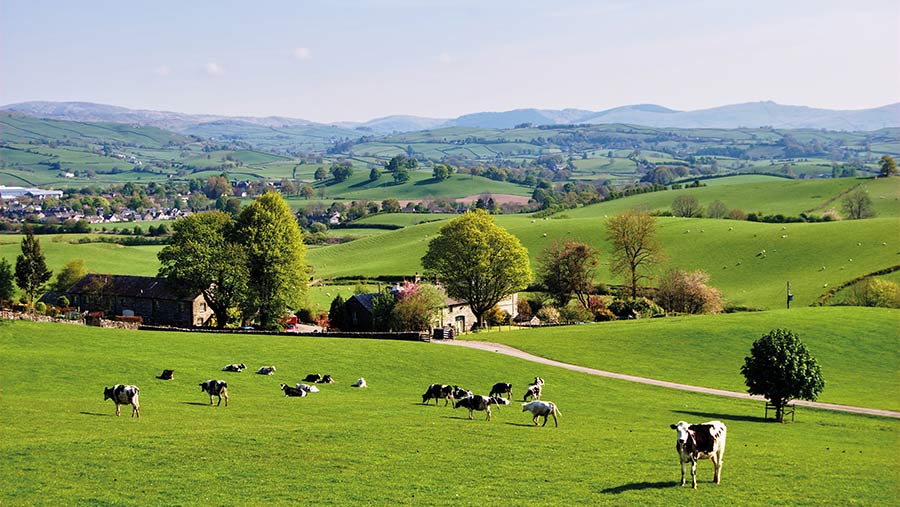Find out average farm rents where you live 2022
 © Kevin Eaves/Adobe Stock
© Kevin Eaves/Adobe Stock All average rents in England increased during the 12 months to February 2021, according to Defra’s most recent Farm Rents report, which uses data from the latest Farm Business Survey.
Both full agricultural tenancy (FAT) and farm business tenancy (FBT) agreements saw a decrease in total area and an increase in average rents, although there remains disparity across the regions.
The average rent/acre remains higher for FBTs than FATs, which are also known as Agricultural Holdings Act (AHA) tenancies – the only tenancy type to record a rent increase the previous year.
See also: Find out average farmland prices where you live
FAT values were recorded to be the highest in the east of England, the South East and the West Midlands, while FBT rents were the highest in the East, the West Midlands and the East Midlands.
FAT agreements
Agricultural tenancies agreed before 1 September 1995 are known as FATs or AHAs. They usually have lifetime security of tenure and many also carry statutory succession rights.
The total area of land under these agreements fell by 1% between 2019 and 2020 to 3.18m acres.
The average rent increased from £72/acre in 2019 to £75/acre.
The North East saw the largest increase (21%), though to just £67/acre, followed by the East (13%) to £104/acre.
The South West saw the largest fall (-6%) in values to £72/acre, while the North West followed with a 4% drop to £63/acre.
By farm type, cereals had the largest increase (10%) in average rent to £91/acre. Lowland grazing livestock was the only other farm type to see an increase – 7% to £78/acre.
All others saw a decrease, with the largest change being less favoured areas grazing livestock, down 4% to just £25/acre.
For agreements with a recorded rent review, the average rent increased 6% from £87/acre to £92/acre.
FBT agreements
FBTs are agricultural tenancies agreed since 1 September 1995 under the Agricultural Tenancies Act.
The total area of land under these agreements fell 3% to just under 3m acres. The average term length was four years and 11 months.
The average rent increased 8% from £90/acre in 2019 to £97/acre in 2020.
The North East saw the largest decrease (-13%) to £82/acre, while the North West rose the most (17%) to £60/acre.
Rents must come down
George Dunn, chief executive of the Tenant Farmers Association, said the main takeaway from the survey was that rents are generally in stasis, despite Defra’s policy line that rents would fall as Basic Payment Scheme monies fell away.
It is clear that rents will need to adjust downwards and the focus will have to be on budgetary evidence to bring them down, he said.
“What is more troubling is the reduction in the amount of FBT [farm business tenancy] land. We expect a year-on-year decrease in the area of land under AHAs [Agricultural Holdings Act tenancies], but this is usually assuaged by increases in the area of land let under FBTs,” said Mr Dunn.
“The results, however, do seem to correlate with what we are hearing from members, with landlords seeking to put themselves in the best position possible to take part in new government financial assistance schemes and private markets for things such as carbon, ecosystems services and biodiversity net gain.”
This underlines why the work of the new Tenancy Working Group is so important, he added.
The only farm type to see a decrease in rent was cereals, which fell 1% to £106/acre.
All others saw an increase in rent, with lowland grazing livestock increasing 30% to £67/acre and general cropping up 23% to £149/acre.
FBT rents for the remaining farm types all rose by less than 10%.
Agreements with a recorded rent review in 2020 saw little change compared with 2019, when the average rent was £100/acre.
Seasonal and informal agreements
The average rent for seasonal agreements (for any term length less than 12 months) increased 1% to £61/acre.
All farm types saw a rise in seasonal rent except lowland grazing livestock, which fell 3% to £47/acre.
The average term length of seasonal agreements was nine months.
Informal agreements – a new category that covers arrangements where there are no formal tenancy agreements and the land is not seasonally let – had an average term length of one year and two months.
Rents increased 4% on the year to £89/acre, with rents in the North East rising a huge 122% to £68/acre.
